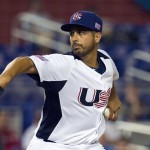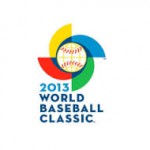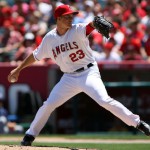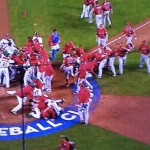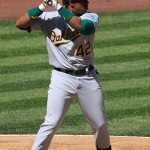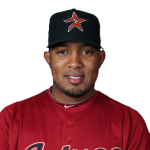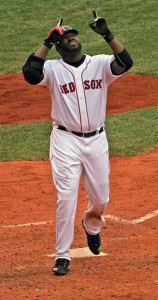
Yes, I’d like to see more DHs like David Ortiz in the league. Photo wiki/flickr user Toasterb
Every once in a while, during a period of time where there’s a relative dearth of topics I’d like to blog about, I scroll through dozens of draft posts and starter topics I’ve got saved and find one worth expanding on. And sometimes one of these random drafts written months or years ago suddenly becomes topical because two hard-ass old-school managers decide to one-up each other in a meaningless spring training game. Further, seeing this random post on Beyond the Box Score, referring to a Joel Sherman article in the NY Post on the topic spurred me into action to dust off this post and put it up for your perusal and criticism.
Summary: Despite mostly considering myself to be a baseball purist, I support going to using full-time Designated Hitter in both leagues. Here’s a few reasons why:
1. Standardize rules between the leagues. It is rather ridiculous that in 2013 half of a major US professional sport plays by such vastly different rules than the other half. It would be as if the NFC in football was forced to attempt 2-point conversions after every touchdown while the AFC forced the use of a point-after attempt instead.
Here’s another interesting observation; i’m pretty sure that the National League is the ONLY baseball league in the country that requires its pitchers to hit. The DH is in use in the minors, in college ball, in HS and AAU ball, and even in lower-level youth leagues (not that anyone would actually use it down that low, when your pitcher is usually your best hitter).
2. Improve the fan experience. As has been more eloquently stated elsewhere, fans would rather see a power hitter batting in the middle of the order than see a feeble .180-hitting starting pitcher batting 9th flail at a 95mph fastball for the 3rd out of each inning. Scoring would rise, and more offense means more excitement for the fans. Forcing pitchers to bat (and, more often than not, bunt) forces managers into a small ball mentality that is counter to most advanced metrics that advocate never trading an out for a base.
3. Let NL fans see more AL Stars in Interleague play. Related to #2; right now in interleague games AL DH’s mostly have to sit, or if they do play another starter has to sit. As an NL home city fan when the Red Sox come to town I don’t want to see Jon Lester hit; I want to see David Ortiz hit.
4. Artificially limiting NL Starting Pitchers. Lack of DH in the NL means that managers are forced to remove starters too early, too often, in order to continue rallies in the middle innings. I’ve even seen people advocate starters getting yanked in the 2nd or 3rd innings of games in certain situations. I’d rather see my starter go as long as he can instead of having the one-out matchup styles of some bullpen managers start in the 5th inning of an (inevitably) 4 hour game.
5. More hitters get longer careers as their defensive skills wane. Right now there’s a number of halfway decent hitters who are older and thus defensive liabilities who have basically been forced out of baseball that could fit in nicely with one of the 15 NL teams that don’t use a DH. If you don’t think the player’s union wouldn’t mind 15 additional jobs for career-twilight veterans (who are mostly at the upper ends of the pay scales), you’re crazy. This is essentially why I think the players union would support a universal DH.
6. Double switches juggled lineup spots is overrated. Purists love it of course, but purists also want baseball to still have the pennant winners immediately advance to the World Series and cringe at divisional play, wild cards and the expanding post-season. But expanding and increasing popularity of the sport means reaching out and appealing to the masses, and the masses interests are the same as purists. One of the big reasons purists maintain support for the DH is because of the notion that these double switches and earlier pitcher man management makes for a better managed game and forces NL managers to be “better.” That’s great and all … but I buy tickets to watch the players play, not to watch some overweight aging manager waddle out to the mound in the 5th inning so he can get a lefty-lefty matchup.
7. NL Teams are at a disadvantage in every inter-league game right now, because they build their rosters for the NL style of play while AL teams are afforded a blank line-up spot for a no-defense slugger all season. AL teams are also allowed to “rest” players and just bat them over the course of the greuling 162-game schedule by virtue of the DH, while NL players get no such luxury, meaning you can make the argument that AL teams have a slight advantage in the World Series against their NL counterparts (not that we actually see this advantage … but in theory it exists). You can make the counter-argument that AL pitchers are ill-prepared to bat as compared to their NL counter-parts, to which I’ll say that a .180 hitting pitcher is only slightly better than a .120 hitting pitcher.
8. Interleague every day means that the #7 issue is exacerbated. This is the gist of the Sherman post; now that Houston is in the AL and there’s 15 teams in each league, there’s inter-league games every day. Which also means that NL teams are even more disadvantaged since they can no longer do roster-maintenance just ahead of known interleague stretches. Likewise, AL teams now have to have their pitchers take BP all throughout the season. Its just a bad strategic situation all around.
9. Pitcher Specialization leading to worse hitting Pitchers. Related to Point #1 (where the MLB NL is the sole league in America that “forces” pitchers to hit), we’re in the midst of an obvious shift in pitcher specialization, both in the majors (bullpen specialized roles) and during development. More and more, kids are identified as superb pitchers early in their amateur careers (in many cases early in high school) and literally stop hitting. At age 15-16. If you’re a grade-A pitching prospect, do you think you want to jeopardize your draft status or your full-ride by screwing around on the base-paths in some meaningless AAU game? I think not. So these kids who havn’t worked on their hitting since their sophomore year in HS then get drafted or go to college, play years of Div-1 or minor league ball, maybe make it to the majors at age 24-25 …. and they havn’t faced live pitching regularly in a decade! Is that what *anyone* really wants?
10. Baseball needs to spur offense: every one knows that the proliferance of upper 90s bullpen arms and the cracking down on PEDs has inevitably led to less offense in the game. Joe Sheehan had a fun stat that pointed out that fans in 2014 were less likely to see a “ball put in play” than at any point since the dead ball era, thanks to the massive spike in strikeouts in the game. Adding a DH and eliminating a position that league-wide bats about .122 would help.
Its time. End the DH. I was hoping for a resolution in the last CBA, but we have to wait a bit longer.
post-publishing edit: for context here was the 2019 slash lines for Pitchers in baseball: Here’s the link: Major League Total Stats ” 2019 ” Pitchers ” Dashboard. they slashed a collective .128/.160/.162 with a staggering 43.5% strikeout rate and a -18 wRC+. 43% strikeout rate! Why do baseball fans advocate to keep this, at the same time when they’re probably complaining about … how often baseball players strike out right now. By way of comparison, here’s the DH slash line for 2019: .252/.339/.467 for a wRC+ of 110.
